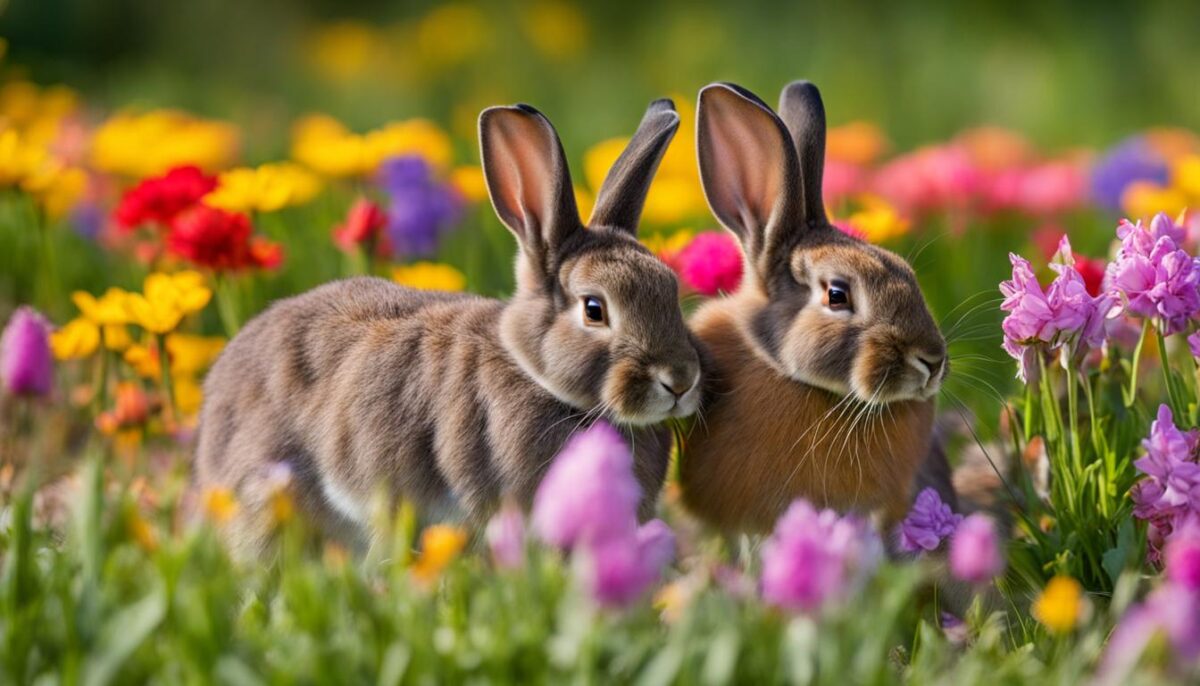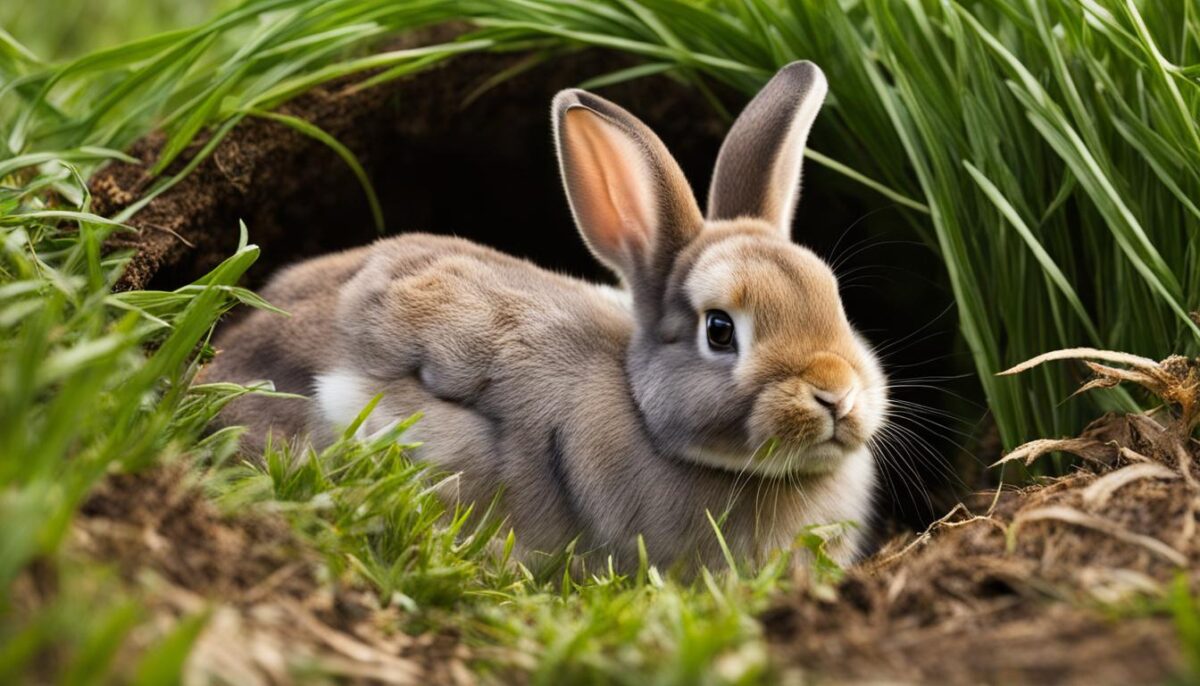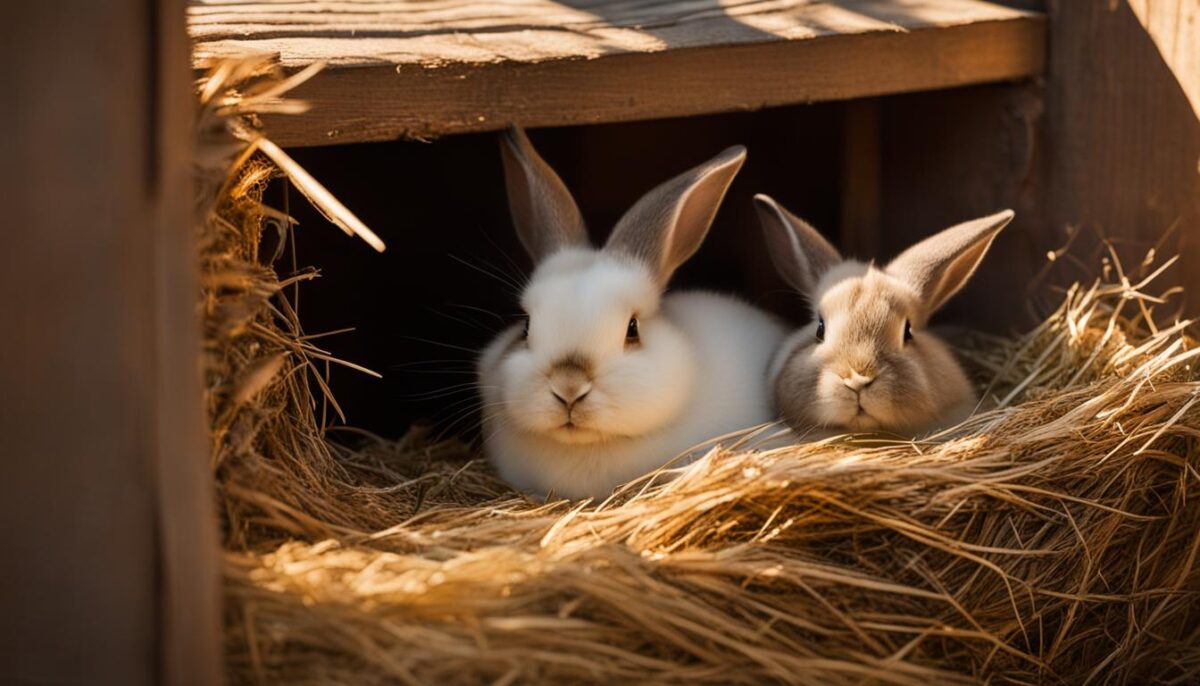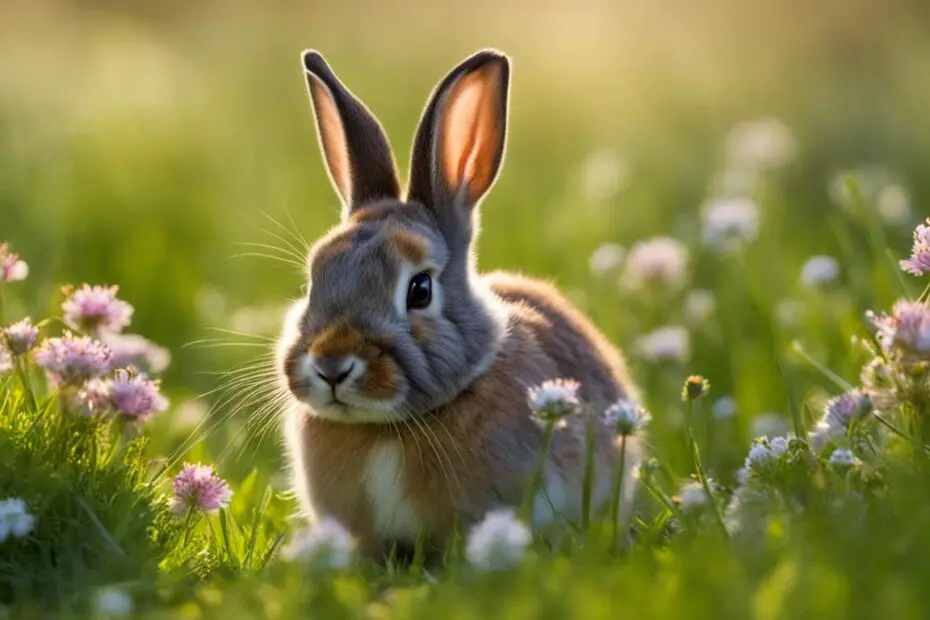Rabbits are fascinating creatures with unique reproductive systems. Many people are curious to know if rabbits have periods like humans. In this article, we will explore the reproductive cycle of rabbits, known as the estrous cycle, and uncover interesting facts about their reproductive system.
Key Takeaways:
- Rabbits do not have menstrual periods like humans.
- Their reproductive cycle, known as the estrous cycle, is regulated by hormonal fluctuations.
- The estrous cycle consists of stages such as proestrus, estrus, metestrus, and diestrus.
- Rabbits are induced ovulators, releasing eggs in response to specific stimuli.
- Understanding rabbit reproduction is essential for responsible pet ownership and breeding.
Understanding Rabbit Reproduction
Rabbits have a unique reproductive system that is quite different from humans. Unlike humans who have menstrual periods, female rabbits go through various stages in their reproductive cycle. This cycle, known as the estrous cycle, is regulated by hormonal fluctuations involving estrogen, progesterone, and luteinizing hormone.
The estrous cycle consists of several stages, including proestrus, estrus, metestrus, and diestrus. Each stage serves a specific purpose in the reproductive process. Female rabbits are induced ovulators, which means they release eggs in response to specific stimuli like mating. It’s important to note that rabbits have a shorter and more frequent estrous cycle compared to humans.
In terms of timing, rabbit breeding season can vary depending on factors such as environmental conditions and availability of resources. However, rabbits are known to be highly fertile and can reproduce throughout the year. Understanding the reproductive hormones and the different stages of the rabbit reproduction cycle is crucial for successful breeding and responsible pet ownership.
Table: Rabbit Reproduction Cycle
| Stage | Description |
|---|---|
| Proestrus | Preparation for mating, increased receptivity |
| Estrus | The period of receptivity and mating |
| Metestrus | Transitional phase after mating |
| Diestrus | Non-receptive phase, hormonal balance |
Understanding the intricacies of rabbit reproduction, including the breeding season, reproductive hormones, and the different stages of the reproductive cycle, is essential for rabbit owners, breeders, and those interested in the fascinating world of rabbit biology.
Behavioral and Physiological Changes
During the rabbit mating season, female rabbits undergo significant behavioral and physiological changes as part of their reproductive cycle. These changes are primarily driven by hormonal fluctuations and play a crucial role in the successful mating and reproduction of rabbits.
Reproductive Behaviors
One of the noticeable behavioral changes in female rabbits during the mating season is an increased receptivity to male rabbits. This heightened receptivity is driven by hormonal changes and is essential for successful mating. Female rabbits may display behaviors such as increased social interaction with males, increased scent marking, and even mounting behaviors.
Hormonal Changes
Physiologically, female rabbits experience hormonal changes during the reproductive cycle. These hormonal fluctuations are responsible for triggering the different stages of the estrous cycle. Hormones such as estrogen, progesterone, and luteinizing hormone play key roles in regulating the timing of ovulation, fertilization, and pregnancy.
“The hormonal changes that occur during the rabbit’s reproductive cycle are crucial for successful mating and reproduction. Understanding these changes can help breeders and caretakers effectively manage and support the reproductive health of female rabbits.”
It’s important to note that the estrous cycle of rabbits does not involve menstruation or shedding of the uterine lining, unlike humans. Female rabbits are induced ovulators, meaning that they release eggs in response to specific stimuli like mating or the presence of a male rabbit. This unique reproductive mechanism further emphasizes the importance of understanding the behavioral and physiological changes that occur during the rabbit mating season.
| Behavioral Changes | Physiological Changes |
|---|---|
| Increased receptivity to male rabbits | Hormonal fluctuations |
| Heightened scent marking | Regulation of ovulation and fertilization |
| Increased social interaction with males | Supporting pregnancy and gestation |
| Mounting behaviors | Induced ovulation in response to stimuli |
Understanding and recognizing these behavioral and physiological changes is essential for rabbit breeders and caretakers. It allows them to provide appropriate care, support successful mating, and ensure the overall reproductive health and well-being of female rabbits.

Misconceptions about Rabbit Reproduction
When it comes to rabbit reproduction, there are several misconceptions that need to be debunked. One of the most common misconceptions is the belief that rabbits have menstrual periods. In reality, rabbits do not experience menstruation like humans do. The estrous cycle in rabbits is different from the menstrual cycle, and there is no shedding of the uterine lining.
Another misconception is that any bleeding observed in rabbits is a sign of a period. However, it’s important to understand that bleeding in rabbits is generally not a normal part of their reproductive cycle. Instead, it is often a sign of a health issue and should be addressed by a veterinarian.
It’s crucial to dispel these misconceptions and understand the unique reproductive system of rabbits. By doing so, we can provide better care for these adorable creatures and ensure their overall well-being.
Image source: rabbit reproduction misconceptions
Understanding Rabbit Reproduction System
Rabbits have a unique reproductive system that differs significantly from humans. Unlike humans, rabbits do not have menstrual periods. Instead, they have a shorter and more frequent reproductive cycle known as the estrous cycle. This cycle is regulated by hormonal fluctuations, primarily involving estrogen, progesterone, and luteinizing hormone.
Female rabbits, also known as does, are induced ovulators, which means they release eggs in response to specific stimuli such as mating or the presence of a male rabbit. The estrous cycle does not involve shedding of the uterine lining like in humans. It is important to understand that rabbits have a distinct reproductive biology.
To further understand the reproductive system of rabbits, it is essential to know the different stages of their estrous cycle. The cycle consists of proestrus, estrus, metestrus, and diestrus. During these stages, does exhibit various behavioral and physiological changes. These changes are driven by hormonal fluctuations and include increased receptivity to males, nesting behaviors, and changes in activity levels.
| Estrous Cycle Stages | Description |
|---|---|
| Proestrus | The period before the doe becomes receptive to mating. |
| Estrus | The receptive period when the doe is ready to mate. |
| Metestrus | The period following mating, during which the doe may still be receptive but less likely to conceive. |
| Diestrus | The period when the doe is not receptive and the uterine environment prepares for possible pregnancy. |
Understanding the reproductive system of rabbits is important for both pet owners and breeders to ensure the well-being and proper care of these animals.
How Rabbit Reproduction Works
Rabbit reproduction follows a fascinating process that involves a gestation period, nesting behavior, and the birth of kits. Understanding these aspects is essential for rabbit owners and breeders. Let’s take a closer look at the various stages of rabbit reproduction.
Gestation Period
The gestation period for rabbits typically lasts around 28-31 days. During this time, the pregnant doe undergoes physical changes to prepare for the birth of her litter. She may exhibit nesting behaviors, such as gathering hay or creating a cozy nest for her kits. It’s important to provide the doe with a suitable nesting area to ensure her comfort and the well-being of the upcoming litter.
Nesting Behavior
Rabbits display instinctive nesting behaviors during pregnancy. They may dig burrows or create nests using materials like hay, straw, or fur. These nests serve as protective environments for the soon-to-be-born kits, providing warmth and security. As a responsible rabbit owner, it is crucial to provide nesting materials and a quiet, safe space for the pregnant doe to fulfill her nesting instincts.
The Reproduction Process
After a successful mating, the doe becomes pregnant and undergoes the gestation period. Once the time is right, she gives birth to her kits. Kits are born blind, deaf, and hairless, relying on their mother for nourishment and warmth. Female rabbits can become pregnant shortly after giving birth, highlighting their high fertility rates.
Understanding how rabbit reproduction works is essential to ensure the well-being of both the mother and her kits. Providing appropriate nesting materials and a comfortable environment for the pregnant doe is crucial for a successful reproduction process.
| Aspect | Description |
|---|---|
| Gestation Period | 28-31 days |
| Nesting Behavior | Creation of nests using hay, straw, or fur |
| The Reproduction Process | Pregnancy, birth of blind, deaf, and hairless kits |

Why Do Female Rabbits Pee Red?
Rabbit urine can sometimes appear red, causing concern among rabbit owners. There are several reasons why female rabbits may have red urine, ranging from harmless dietary factors to underlying health conditions. It’s important to understand the possible causes to determine whether a veterinarian’s intervention is necessary.
Possible Reasons for Red Urine in Rabbits:
- Diet: Certain foods, such as beetroot or foods containing red food dyes, can cause the urine to appear red. This discoloration is usually temporary and should resolve once the food is digested.
- Dehydration: When rabbits are dehydrated, their urine can become more concentrated, leading to a darker or reddish color. Ensuring your rabbit has access to fresh water at all times can help prevent dehydration.
- Hematuria: Hematuria refers to the presence of blood in the urine. It can be caused by conditions such as urinary tract infections, bladder stones, or kidney disease. If you notice consistent red urine or other signs of illness in your rabbit, it’s essential to consult a veterinarian for a proper diagnosis and treatment.
- Dietary Supplements and Medications: Some supplements or medications may cause changes in urine color. Consult your veterinarian if you suspect that a specific supplement or medication is causing the red urine.
- Underlying Health Conditions: In rare cases, red urine may be a symptom of a more serious underlying health condition. Kidney or bladder infections, tumors, or inflammation can cause blood to appear in the urine. If your rabbit’s urine consistently appears red and is accompanied by other signs of illness, it is crucial to seek veterinary advice.
While red urine in rabbits can be concerning, it is not always a cause for alarm. By monitoring your rabbit’s behavior, diet, and overall health, you can better determine the cause of red urine and take appropriate action if necessary. If in doubt, it is always best to consult with a veterinarian who can provide guidance and ensure the well-being of your furry friend.
Do Does Have Periods After Giving Birth?
After giving birth, female rabbits do not experience periods or uterine shedding. Instead, they focus on nursing and caring for their kits during the postpartum period. This time is crucial for their recovery and the well-being of their offspring.
Unlike humans, rabbits have a unique reproductive system called the estrous cycle. This cycle is regulated by hormonal fluctuations and does not involve the shedding of the uterine lining. After giving birth, female rabbits go through a period of rest and recovery, during which their bodies heal and prepare for future pregnancies.
During the postpartum period, it is essential to provide female rabbits with a comfortable and stress-free environment. This includes providing them with a private nesting area, plenty of fresh water, and a high-quality diet to support their milk production and overall health. It is also important to monitor the health of the kits and ensure they are nursing properly.

In conclusion, female rabbits do not have periods after giving birth. They go through a postpartum recovery period where they focus on caring for their kits and regaining their strength. Understanding the unique reproductive biology of rabbits is essential for providing appropriate care and ensuring the well-being of these fascinating animals.
Rabbit Reproduction Myths and Facts
There are several common myths surrounding rabbit reproduction that can lead to misunderstandings and misinformation. It’s important to separate these myths from the facts to ensure accurate knowledge and proper care for these adorable creatures.
Myth: Rabbits have periods
One of the most prevalent misconceptions is that rabbits have menstrual periods like humans. In reality, rabbits do not experience menstrual bleeding or the shedding of the uterine lining. Their reproductive system, known as the estrous cycle, is different from humans and involves hormonal fluctuations.
During the estrous cycle, female rabbits go through different stages, including proestrus, estrus, metestrus, and diestrus. These stages are regulated by hormones such as estrogen, progesterone, and luteinizing hormone. Rabbits are induced ovulators, meaning they release eggs in response to specific stimuli like mating, rather than having a regular menstrual cycle.
Fact: Continuous fertility is a myth
Another misconception is that rabbits are continuously fertile. While it is true that rabbits have a shorter, more frequent estrous cycle compared to humans, they can only get pregnant during specific stages. It’s important to understand the timing of the estrous cycle and the receptive period for successful breeding.
| Myth | Fact |
|---|---|
| Rabbits have periods | Rabbits do not have menstrual periods, but go through an estrous cycle. |
| Rabbits are continuously fertile | Rabbits can only get pregnant during specific stages of their estrous cycle. |
Understanding the facts about rabbit reproduction is essential for responsible pet ownership and breeding. By dispelling these myths, we can provide better care for these enchanting creatures.
Conclusion
In conclusion, understanding rabbit reproductive biology is essential for responsible pet ownership and breeding. Rabbits have a unique reproductive system known as the estrous cycle, which is regulated by hormonal fluctuations. Unlike humans, rabbits do not have periods. Instead, they go through various stages in their reproductive cycle, including proestrus, estrus, metestrus, and diestrus.
During their reproductive cycle, female rabbits exhibit behavioral and physiological changes driven by hormonal fluctuations. These changes include increased receptivity to male rabbits, nesting behaviors, and changes in activity levels. It’s important to note that the estrous cycle does not involve menstruation or shedding of the uterine lining.
Rabbit reproduction myths and misconceptions, such as the belief that rabbits have continuous fertility or experience visible bleeding during their estrous cycle, should be dispelled. Understanding the facts about rabbit reproduction will help ensure accurate care and prevent misunderstandings.
Overall, by comprehending the intricacies of rabbit reproductive biology, we can provide optimal care for these fascinating animals and ensure their health and well-being.
FAQ
Do rabbits have periods?
No, rabbits do not have periods like humans. They have a unique reproductive system called the estrous cycle.
How is the rabbit reproductive cycle regulated?
The rabbit reproductive cycle is regulated by hormonal fluctuations, primarily involving estrogen, progesterone, and luteinizing hormone.
What are the behavioral and physiological changes that occur during the rabbit reproductive cycle?
Female rabbits undergo complex behavioral and physiological changes during their reproductive cycle, including increased receptivity to male rabbits, nesting behaviors, and changes in activity levels.
Are there any misconceptions about rabbit reproduction?
Yes, there are several misconceptions about rabbit reproduction, including the idea that rabbits have menstrual periods.
How does the rabbit reproductive system work?
Rabbits have a unique reproductive system that differs significantly from humans. They do not have monthly reproductive cycles like humans but instead have a shorter, more frequent estrous cycle.
What is the gestation period for rabbits?
The gestation period for rabbits typically lasts around 28-31 days.
Why do female rabbits sometimes pee red?
Rabbit urine can appear red due to various factors, including diet, dehydration, hematuria (blood in urine), dietary supplements, medications, plant pigments, and underlying health conditions.
Do female rabbits have periods after giving birth?
No, female rabbits do not have periods or uterine shedding after giving birth. They focus on nursing and caring for their kits during the postpartum period.
What are some common myths about rabbit reproduction?
There are several myths surrounding rabbit reproduction, including misconceptions about periods and continuous fertility.
What are some key facts to understand about rabbit reproduction?
Understanding the facts about rabbit reproduction is crucial for responsible pet ownership and breeding.


